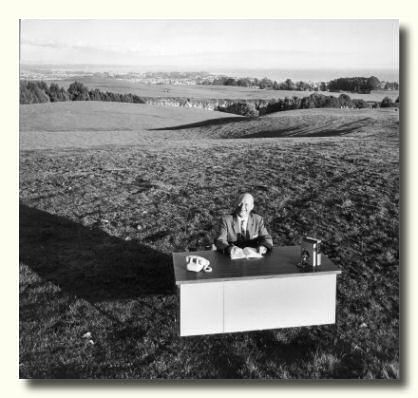A Brief History
Situated on what is now the campus of the University of California at Santa Cruz and what was originally part of the vast land holdings of pioneer settler Henry Cowell, the Arboretum & Botanic Garden occupies one of the most propitious horticultural sites in the world. The climatic and topographic diversity is such as to allow experimentation with almost every species that might be grown along the coast between San Diego and Crescent City, and the diversity of the soils--the underlying rock includes granite, schist, limestone, and several types of sandstone--can scarcely be matched anywhere.
In the beginning
The Arboretum had its official start in 1964 with a gift of about 90 species of eucalyptus. In 1967 founding Chancellor Dean E. McHenry formed an Arboretum and Plantations Committee to advance the project.

Dean McHenry poses for a magazine photo in the meadow above the present site of the Arboretum. Photo credit: Vester Dick, Covello & Covello
With the interest and enthusiasm of Chancellor McHenry and the contributions of countless friends and supporters, Dr. Ray Collett began to expand the infant Arboretum's collections, focusing especially on plants of the Southern Hemisphere. In addition to the eucalypts a comprehensive collection of conifer genera was acquired. The Arboretum broke new ground in the propagation of the exotic South African proteas, formerly believed to be "difficult" horticultural subjects, and soon had many hundreds growing happily in a former cow pasture. Hundreds of fine horticultural selections of Australian plants were sent to the Arboretum and propagated for the first time in America. A matchless collection of "living fossils" was amassed, used by researchers the world over in the study of evolutionary biology.
"The Arboretum grew out of the rarest combination of propitious events and superlative opportunities. In 1965 how remarkable it was! The choicest horticultural site in all of flowery California was open and available just where a new campus of the University was to grow." -- Ray Collett, Founding Arboretum Director and Professor Emeritus of Natural History

Ray Collett
The Friends of the Arboretum
In order to open up the Arboretum to wider use and participation, the Arboretum Associates, now the Friends of the UC Santa Cruz Arboretum, a friends group, was formed in November 1976 as a non-profit organization with 113 charter members. It has now expanded to 800 members, and serves to raise funds and bring the Arboretum's activities to the attention of the local community through lectures, a yearly symposium, plant sales, and a monthly newsletter.
Many Collections
The Elvenia J. Slosson Research Gardens were established in 1978 to provide a testing ground for new Australian ornamentals, and in 1984, the Edward D. Landels New Zealand Garden was inaugurated. The Arboretum continues to augment and maintain these collections and many more. They are enduring value to researchers, instructors, horticulturalists, artists, and the general public. Over the years, the UC Santa Cruz Arboretum has become recognized as one of the great gardens of the world.
Arboretum Celebrating Fifty Years in 2015
The Arboretum started with 80 unusual and rare eucalyptus trees. 50 years later we have the:
- World's largest collection of Australian plants outside of Australia
- World's largest Dudleya (a type of succulent) collection
- One of the largest collection of New Zealand plants outside of New Zealand
- An important conifer collection utilized for research and conservation and
- A growing California native flora collection
For the last 50 years, with the help of hundreds of volunteers, members, and donors, these gardens have grown to 135 acres! Our collections are home to a wide range of rare, extraordinary, and critical plants. Today they are a key part of conserving some of the world's biodiversity hotspots, the richest, and most critically endangered ecosystems in the world. These collections establish us as leaders in regional conservation during a time when the world faces unprecedented species loss, climate change, and transforming ecosystems. Read more on the Arboretum's first fifty years.
With over 20,000 visitors a year and as one of the top 12 attractions in Santa Cruz according to TripAdvisor, the Arboretum plays a key role in engaging researchers, students, and community members to protect and steward our fragile environs.
